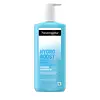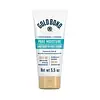What's inside
What's inside
 Key Ingredients
Key Ingredients

 Benefits
Benefits

 Concerns
Concerns

 Ingredients Side-by-side
Ingredients Side-by-side

Water
Skin ConditioningHydroxyethyl Urea
HumectantCaprylic/Capric Triglyceride
MaskingDimethicone
EmollientGlycerin
HumectantStearyl Alcohol
EmollientVitis Vinifera Seed Oil
EmollientGlyceryl Stearate
EmollientSodium Hyaluronate
HumectantCeramide NP
Skin ConditioningGluconolactone
Skin ConditioningSteareth-21
CleansingNiacinamide
SmoothingGuar Hydroxypropyltrimonium Chloride
Skin ConditioningCholesterol
EmollientCeramide Ns
Skin ConditioningPolysorbate 60
EmulsifyingEthylhexylglycerin
Skin ConditioningPanthenol
Skin ConditioningCeramide EOP
Skin ConditioningCaprooyl Phytosphingosine
Skin ConditioningPolyacrylate Crosspolymer-6
Emulsion StabilisingCeramide Eos
Skin ConditioningHydroxyacetophenone
AntioxidantCetyl Alcohol
EmollientCeramide AP
Skin ConditioningCaprooyl Sphingosine
Skin ConditioningTocopherol
AntioxidantCetearyl Alcohol
EmollientDisodium EDTA
Ceteareth-25
Cleansing3-O-Ethyl Ascorbic Acid
Skin ConditioningBehenic Acid
CleansingWater, Hydroxyethyl Urea, Caprylic/Capric Triglyceride, Dimethicone, Glycerin, Stearyl Alcohol, Vitis Vinifera Seed Oil, Glyceryl Stearate, Sodium Hyaluronate, Ceramide NP, Gluconolactone, Steareth-21, Niacinamide, Guar Hydroxypropyltrimonium Chloride, Cholesterol, Ceramide Ns, Polysorbate 60, Ethylhexylglycerin, Panthenol, Ceramide EOP, Caprooyl Phytosphingosine, Polyacrylate Crosspolymer-6, Ceramide Eos, Hydroxyacetophenone, Cetyl Alcohol, Ceramide AP, Caprooyl Sphingosine, Tocopherol, Cetearyl Alcohol, Disodium EDTA, Ceteareth-25, 3-O-Ethyl Ascorbic Acid, Behenic Acid
 Reviews
Reviews

Ingredients Explained
These ingredients are found in both products.
Ingredients higher up in an ingredient list are typically present in a larger amount.
Cetyl Alcohol is a fatty alcohol. Fatty Alcohols are most often used as an emollient or to thicken a product.
Its main roles are:
Though it has "alcohol" in the name, it is not related to denatured alcohol or ethyl alcohol.
The FDA allows products labeled "alcohol-free" to have fatty alcohols.
Learn more about Cetyl AlcoholDimethicone is a type of synthetic silicone created from natural materials such as quartz.
What it does:
Dimethicone comes in different viscosities:
Depending on the viscosity, dimethicone has different properties.
Ingredients lists don't always show which type is used, so we recommend reaching out to the brand if you have questions about the viscosity.
This ingredient is unlikely to cause irritation because it does not get absorbed into skin. However, people with silicone allergies should be careful about using this ingredient.
Note: Dimethicone may contribute to pilling. This is because it is not oil or water soluble, so pilling may occur when layered with products. When mixed with heavy oils in a formula, the outcome is also quite greasy.
Learn more about DimethiconeEthylhexylglycerin (we can't pronounce this either) is commonly used as a preservative and skin softener. It is derived from glyceryl.
You might see Ethylhexylglycerin often paired with other preservatives such as phenoxyethanol. Ethylhexylglycerin has been found to increase the effectiveness of these other preservatives.
Glycerin is already naturally found in your skin. It helps moisturize and protect your skin.
A study from 2016 found glycerin to be more effective as a humectant than AHAs and hyaluronic acid.
As a humectant, it helps the skin stay hydrated by pulling moisture to your skin. The low molecular weight of glycerin allows it to pull moisture into the deeper layers of your skin.
Hydrated skin improves your skin barrier; Your skin barrier helps protect against irritants and bacteria.
Glycerin has also been found to have antimicrobial and antiviral properties. Due to these properties, glycerin is often used in wound and burn treatments.
In cosmetics, glycerin is usually derived from plants such as soybean or palm. However, it can also be sourced from animals, such as tallow or animal fat.
This ingredient is organic, colorless, odorless, and non-toxic.
Glycerin is the name for this ingredient in American English. British English uses Glycerol/Glycerine.
Learn more about GlycerinSodium Hyaluronate is hyaluronic acid's salt form. It is commonly derived from the sodium salt of hyaluronic acid.
Like hyaluronic acid, it is great at holding water and acts as a humectant. This makes it a great skin hydrating ingredient.
Sodium Hyaluronate is naturally occurring in our bodies and is mostly found in eye fluid and joints.
These are some other common types of Hyaluronic Acid:
Learn more about Sodium HyaluronateWater. It's the most common cosmetic ingredient of all. You'll usually see it at the top of ingredient lists, meaning that it makes up the largest part of the product.
So why is it so popular? Water most often acts as a solvent - this means that it helps dissolve other ingredients into the formulation.
You'll also recognize water as that liquid we all need to stay alive. If you see this, drink a glass of water. Stay hydrated!
Learn more about Water